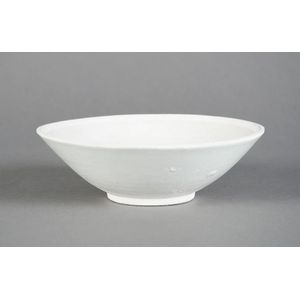White-glazed Qing dynasty stembowl with dragon design
You must be a subscriber, and be logged in to view price and dealer details.
Subscribe Now to view actual auction price for this item
When you subscribe, you have the option of setting the currency in which to display prices to $Au, $US, $NZ or Stg.
- Qing Dynasty - The Qing Dynasty was the last imperial dynasty of China, ruling from 1644 to 1912. It was established by the Manchu people, who originated from the northeastern region of China. The Qing Dynasty was preceded by the Ming Dynasty and followed by the Republic of China.
- Hollow Stem - Some 18th century wine glasses had a hollow stem for collecting wine sediment, but now the hollow stem is sometimes incorporated into the design of champagne glasses to emphasise the effect created by the effervescence.
- Incised - A record of a name, date or inscription, or a decoration scratched into a surface, usually of a glass or ceramic item with a blunt instrument to make a coarse indentation. Compare with engraving where the surface is cut with a sharp instrument such as a metal needle or rotating tool to achieve a fine indentation.
- Ming Dynasty - The Ming Dynasty was a ruling dynasty of China from 1368 to 1644. It succeeded the Yuan Dynasty and preceded the Qing Dynasty. The Ming Dynasty was established by Zhu Yuanzhang, a former Buddhist monk who became a rebel leader and eventually overthrew the Mongol Yuan Dynasty. During the Ming Dynasty, China experienced a period of relative stability and prosperity. The government was centralized and bureaucratic, with the emperor at the top of the hierarchy. The Ming Dynasty is known for its cultural achievements, including the development of porcelain, the invention of movable type printing, and the construction of the Great Wall of China.
This item has been included into following indexes:
Visually similar items

A Chinese Qingbai bowl, Song Dynasty 960-1279, with greenish glaze and biscuit rim, 18.8 cm diameter. Provenance: Private NSW Southern Highlands collection

A Chinese stem cup, late Qing Dynasty, late 19th century of simple and typical form raised upon a gently flaring base, in fine white porcelain and unadorned; bearing possible underglaze Daoguang marks underside. Height 8 cm

Small late Ming (?) blanc de chine wine cup. Height 4 cm. Diameter 7 cm

A Chinese Ding-type white ware bowl, Song Dynasty 960-1279, finely moulded on the inside with a continuous floral design, heavily crackled ivory-coloured glaze. 8 cm high, 18.8 cm diameter, fitted box. Provenance: Sydney private collection. R & V Tregaskis
